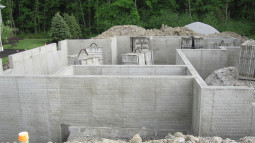 We’ve all heard the parable of the wise and foolish builders; how one built his house on rock and the other built his on sand and how they fared during a storm. While we know that the parable is about more than just their choice of building plots, the land you build on and its soil type is of significant importance when constructing any building.
We’ve all heard the parable of the wise and foolish builders; how one built his house on rock and the other built his on sand and how they fared during a storm. While we know that the parable is about more than just their choice of building plots, the land you build on and its soil type is of significant importance when constructing any building.
The importance of the right foundations
The purpose of foundations is to distribute the weight of the building over a sufficient surface to prevent unequal settlement of the structure. The depth of the foundations will vary according to the characteristics of the subsoil and there are several different types of foundations which are used according to the quality of the earth on which the building is to be constructed.
Strip Foundations are a continuous strip of concrete laid to support load bearing walls. If strip foundations need to be at deeper level to reach suitable soil, wider and deeper trenches are excavated with the strip foundations being dug and poured at a lower level. Support walls are then built to ground level. When the soil is very soft or has a low load-bearing capacity, wide strip foundations reinforced with steel are used so that the load is spread over a larger area.
Trenchfill Foundations are often used in place of deep strip foundations and are dug to a depth where the subsoil is able to provide sufficient load bearing capacity before being filled with concrete.
Raft Foundations are the solution for very weak soils such as clay as they allow the building to literally ‘float’ on the soil. Made of reinforced concrete, they are often used as an alternative to piles as they are more economical.
Piled Foundations are used when the ground is unable to support strip foundations and the depth of trench fill foundations proves either uneconomical or impractical. Piles can be bored and cast in situ or pre-cast reinforced concrete piles driven into place until they meet with stronger strata. Two to three metre short bore piles are connected at the top by a network of precast horizontal concrete beams as a base for a concrete floor.
What’s beneath your feet?
Rocks such as granite, sandstone, limestone and hard chalk all have a high bearing capacity and although they may need stripping back and levelling, they provide a stable surface to build on. Chalks are suitable for strip foundations but if the chalk is soft it will need excavating until hard chalk is reached.
Strip foundations can also be used for gravel and sandy sub soils as long as the ground has an adequate bearing capacity although, as trenches are prone to collapse, sheet piling is often recommended to preserve the ground until the concrete is poured.
Depending on the moisture content, the top layer of clay can be subject to movement due to expansion and shrinkage, therefore it’s necessary to dig foundations deep enough to reach a depth where the moisture content is stable. If your land is covered with peat or loose waterlogged sand, unless you can uncover suitable load bearing ground, a reinforced raft foundation will be necessary.
